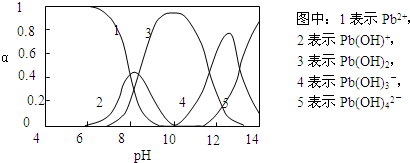Ⅰ.氮是地球上含量丰富的一种元素,氮及其化合物在工农业生产、生活中有着重要作用.请回答:
(1)在一定体积的恒容密闭容器中,进行如下化学反应:N2(g)+3H2(g)

2NH3(g)
其化学平衡常数K与温度t的关系如下表:
| t/K | 298 | 398 | 498 | … |
| K/(mol•L-1)2 | 4.1×106 | K1 | K2 | … |
①比较K1、K2的大小:K1______K2(填“>”、“=”或“<”).
②判断该反应达到化学平衡状态的依据是______(填序号).
A.2v(H2)(正)=3v(NH3)(逆) B.v(N2)(正)=3v(H2)(逆)
C.容器内压强保持不变 D.混合气体的密度保持不变
(2)盐酸肼(N2H6Cl2)是一种重要的化工原料,属于离子化合物,易溶于水,溶液呈酸性,水解原理与NH4Cl类似.
①写出盐酸肼第一步水解反应的离子方程式______.
②盐酸肼水溶液中离子浓度的排列顺序正确的是______(填序号).
A.c(Cl-)>c(N2H62+)>c(H+)>c(OH-)
B.c(Cl-)>c([N2H5•H2O+])>c(H+)>c(OH-)
C.c(N2H62+)+c([N2H5•H2O+])+c(H+)=c(Cl-)+c(OH-)
D.c(N2H62+)>c(Cl-)>c(H+)>c(OH-)
Ⅱ.水体中重金属铅的污染问题备受关注.查资料得知Pb4+具有很强的氧化性.水中铅的存在形态主要有Pb2+、Pb(OH)+、Pb(OH)2(在水中溶解度小)、Pb(OH)3-、Pb(OH)42-,各形态的物质的量的分数α随溶液pH变化的关系如下图所示:

(1)Pb(NO3)2溶液中,c(Pb2+)/c(NO3-)______1/2(填“>”、“=”、“<”).
(2)向Pb(NO3)2溶液滴加盐酸,溶液中c(Pb2+)/c(NO3-)没有变大,反而变小并有沉淀生成,则生成的沉淀可能为______.
(3)向Pb(NO3)2溶液中滴加NaOH溶液,溶液也变浑浊,在pH约为______ 时生成沉淀最多,继续滴加NaOH溶液,混合体系又逐渐变澄清.pH=13时,混合体系中发生的主要反应的离子方程式为:______.
Ⅰ.(1)①因该反应为放热反应,则温度升高,化学平衡向逆反应方向移动,即升高温度K变小,则K1>K2,故答案为:>;
②由化学平衡的特征可知,A转化为:2v(H2)(正)=3v(NH3)(正)=3v(NH3)(逆),则正逆反应速率相等,达到平衡,而B转化为同一物质不能满足正逆反应速率相等,
该反应是反应前后物质的量不等的反应,则压强不变可说明化学反应达到平衡,而D中质量始终不变,密闭容器的体积不变,则混合气体的密度始终不变,则不能作为判断平衡的依据,故答案为:AC;
(2)①因水解与NH4Cl类似,则N2H62+水解结合H2O电离生成的OH-,则水解离子反应为N2H62++H2O

[N2H5•H2O]++H+,故答案为:N2H62++H2O

[N2H5•H2O]++H+;
②由盐酸肼的化学式为N2H6Cl2,则c(Cl-)>c(N2H62+),又水解显酸性,则c(H+)>c(OH-),由水解的程度很弱,则c(N2H62+)>c(H+),即离子浓度的大小关系为
c(Cl-)>c(N2H62+)>c(H+)>c(OH-),故A正确;显然D错误;由水解方程式可知c([N2H5•H2O+])=c(H+),故B错误;正确的电荷守恒式为
2c(N2H62+)+c([N2H5•H2O+])+c(H+)=c(Cl-)+c(OH-),故C错误;故答案为:A;
Ⅱ.(1)因Pb在溶液中有多种存在形态,则Pb(NO3)2溶液中,c(Pb2+)/c(NO3-)<1/2,故答案为:<;
(2)由加入盐酸,pH变小,结合图可知Pb2+增多,但c(Pb2+)/c(NO3-)没有变大,反而变小并有沉淀生成,则只能是Pb2+与Cl-离子结合生成沉淀PbCl2,故答案为:PbCl2;
(3)由图中的曲线3可知,pH=10时生成沉淀最多,继续加氢氧化钠,由曲线4、5可知,pH=13时发生Pb(OH)3-转化为Pb(OH)42-的离子反应,离子反应为Pb(OH)3-+OH-=Pb(OH)42-,
故答案为:10;Pb(OH)3-+OH-=Pb(OH)42-.

 a yell. You might teach a young child a few “friendship 51 ”, such as “My name’s Tom. What’s yours? Do you want to play games?”
a yell. You might teach a young child a few “friendship 51 ”, such as “My name’s Tom. What’s yours? Do you want to play games?” ce C. when D. as
ce C. when D. as liked
liked